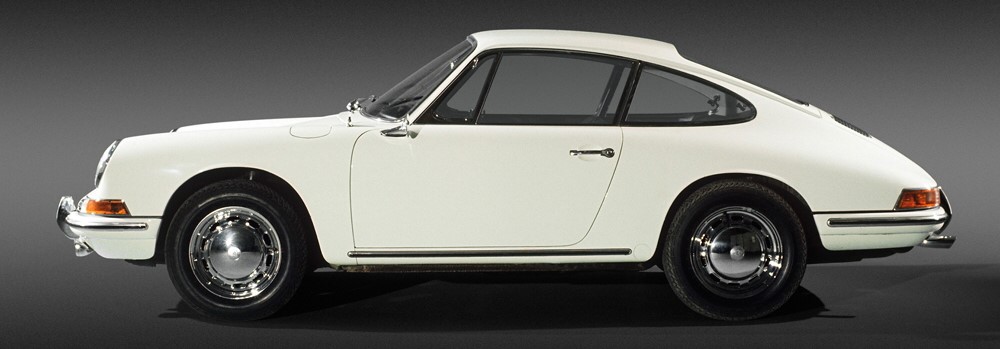
The Original 911 – The birth of an icon – As the successor to the Porsche 356, the 911 conquered the hearts of sports car fans right from the start. The very first 911 began life as the Type 901 at the Frankfurt Motor Show in 1963. The name was changed for its market launch in 1964. The air-cooled, flat-6 engine delivered 130 hp – enough for a genuine 210 kilometres per hour. Drivers preferring to go a little less fast could from the following year order the four-cylinder Porsche 912.
In 1966, Porsche launched the 911 S. Producing 160 hp, it was the first 911 to sport Fuchs forged alloy wheels. The 911 Targa came onto the market at the end of 1966 and with its striking stainless steel roll bar became the world’s first super-safe convertible. From the following year, the 911 was available with ‘Sportomatic’, a semi-automatic, four-speed transmission. And with the 911 T, E and S models Porsche became the first German carmaker to fulfil the American Environmental Protection Agency’s strict anti-pollution exhaust requirements. With engine capacity increases to 2.2 litres (in 1969) and 2.4 litres (in 1971) the Porsche 911 became ever more powerful. To this day still the dream car to beat all others: the 911 Carrera RS 2.7 from 1972. Engine power of 210 hp and just 1,000 kilograms in weight. Its characteristic ‘ducktail’ was the first rear spoiler fitted as standard to a production car anywhere in the world.
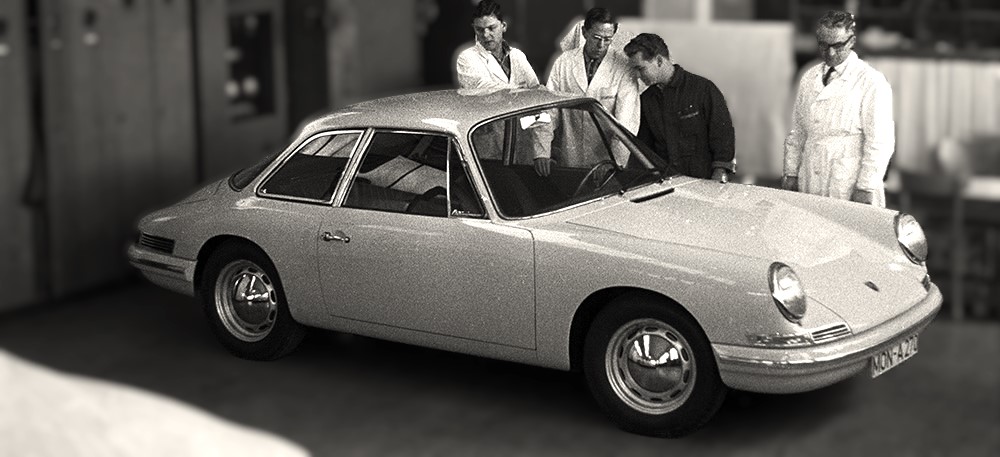
1963-1964
In 1963 Porsche proudly presented the successor to the 356 at the Frankfurt Motor Show: the original 911. The 911 differed in many respects from its predecessor, not only through its fast-revving six-cylinder power unit. And Ferry Porsche was happy “to be able at last to fit his golf set into the car without a problem.” Originally code-named the 901, the model designation had to be changed into the magical numbers 911, since Peugeot claimed the right to all three-digit numbers with a zero in the middle.
Porsche 911 2.0 Coupé
Year of production: 1964
Power unit: six-cylinder boxer engine
Capacity: 1991 cc
Output: 130 bhp (96 kW)
Top speed: 210 km/h (130 mph)
1963, Three-Part Safety Steering System
For its launch in 1963, the Porsche 911 was fitted with rack-and-pinion steering which had already been praised for its precise and very direct mode of operation in previous test reports. This steering system was also part of the vehicle’s safety concept. The linkage had a three-part design and the steering box was positioned in the centre of the vehicle. Therefore the steering wheel did not move directly towards the driver in the event of frontal impact but, due to the steering rod angle, moved away from the driver via the impact tubes and the release elements.
Porsche continued to improve the safety steering system. Subsequent generations also featured a mesh tube as the crumple element. From 1991, Porsche was the first car manufacturer to equip all its models with driver and front passenger airbags as standard.
1966-1967
1966: Internally ventilated disc brakes
Effective cooling of the brakes is important in a high-performance vehicle – only then can they stably and repeatedly brake the car at high speeds. Therefore Porsche introduced internally ventilated discs to the 911 S as early as 1966. These discs are double-walled so that air can circulate and frictional heat is reduced. Furthermore, the perforations also have the advantage that water spray is conducted away from the discs very quickly.
To improve cooling even more, the disc brake systems on later 911 types also have ram air ducts that guide fresh air through channels onto the brake discs from the front – from openings in the spoiler. No other manufacturer invests so much know-how into the brake systems on their series production cars as Porsche. This is because no other manufacturer has as much experience from motor racing as Porsche. The reason being that Porsche has always developed the brake systems for its racing cars itself.
The rewards for all this effort are not only brake systems that are extremely stable and therefore play their part in high-precision driving, the Porsche series production vehicles also always boast the shortest braking distances in their class – a significant safety benefit on public roads.
1967: Targa roll-over protection bar
The first standard safety cabriolet in the world – these were the headlines when Porsche presented the first 911 Targa at the IAA in September 1965. The innovation in the new sports car model was the fixed Targa bar, derived from the roll-over protection bar which had proven itself in motor racing events and guaranteed a high level of protection for the occupants. With its removable folding roof and the plastic rear window that could be folded down, the 911 Targa was also extremely flexible and offered its occupants no less than four different options for open-top or closed-top driving. And the hood concept, patented in August 1965, also had other advantages.
It solved the problem of the fabric hood bulging unattractively at speed on motorways just as reliably as it did the issue of body distortion, which was common with convertibles at that time. However, the main concept behind the 911 Targa was clearly its high standard of passive safety which was appreciated by many customers. As early as the beginning of the 1970s the Targa had an approximately 40 per cent share of the 911 series.
1971
1971, 911 Targa 2.2 litre
In response to new, strict legislation in the USA, Porsche built the first production safety convertible in the world to meet this challenge: In the mid-60s Porsche’s engineers created a special version of the 911 positioned in between the Cabriolet and the Coupé, inventing the Targa principle. This Targa version with its stable, removable roof quickly won over the hearts of a very special group of customers. Even the most powerful S-model (S for Sport) was available with the typical rollbar.
Porsche 911 S 2.2 Targa
Year of production: 1970
Power unit: six-cylinder boxer engine
Capacity: 2195 cc
Output: 180 bhp (132 kW)
Top speed: 230 km/h (143 mph)
1972
1972, 911 Carrera RS, 2.7 litre
The fastest German production car of its time was characterised by its unique rear spoiler referred to in popular terms as the “ducktail”. Introducing all kinds of aerodynamic improvements, Porsche set an important trend through this particular model, this spartan coupé living out the concept of “more power through more displacement and less weight” without the slightest compromise. The RS 2.7 was the first 911 to bear the name “Carrera” derived from the classic Carrera Panamericana road race.
Porsche 911 Carrera RS 2.7 Coupé
Year of production: 1973
Power unit: six-cylinder boxer engine
Capacity: 2687 cc
Output: 210 bhp (154 kW)
Top speed: 240 km/h (149 mph)
1972: Front and rear spoilers
The Porsche engineers have worked unceasingly to make the entire 911 package even better. This includes improved aerodynamics – which was taken into account in 1971 with the first front spoiler, based on knowledge taken directly from the field of motor racing. It was used on the 911 S and later on the 911 E. The spoiler guided the air away to the side, thus reducing the lift on the front section. It improved directional stability and made the car easier to handle.
The 911 T was also fitted with the front spoiler one year later. The 911 Carrera RS 2.7 introduced the rear spoiler – it featured the distinctive “ducktail” and was one of the reasons why this type became a cult car. The next rear spoiler which could genuinely be called “historic” was that on the 911 Turbo. Its large, flat design adorned the vehicle and, in addition to its reliable function, it was also a statement about the power and the speed of the Turbo.
To briefly explain the technical principle: spoilers at the front and rear enhance the vehicle’s aerodynamics and improve directional stability, braking and steering characteristics, cornering behaviour and the car’s response to cross winds, especially at high speeds. They guide the air around the outside of the vehicle (front spoiler) and prevent too much air underneath the car which would result in unnecessary lift and significant turbulence on the underside of the vehicle, especially if it is not lined and therefore has clefts.
The role of the rear spoiler is to discharge the air flowing around the vehicle at the right place, the spoiler lip, with as little turbulence as possible. The rear spoiler being designed as a wing in the form of an upside-down aeroplane wing makes it possible to increase the negative lift on the rear wheels and therefore generate downforce. The vehicle’s even air flow and the controlled negative lift increase the top speed and reduce fuel consumption.

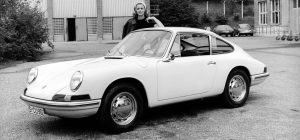


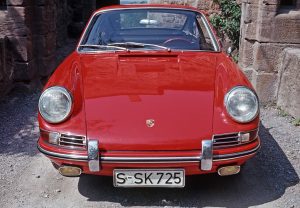

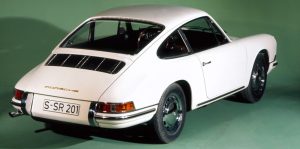
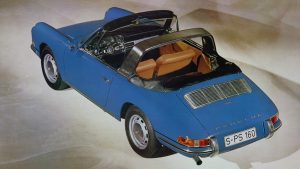
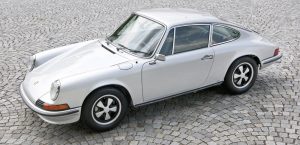
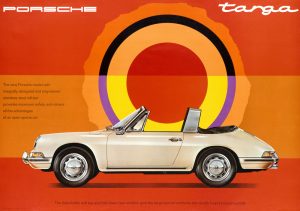


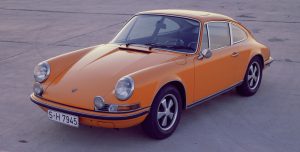




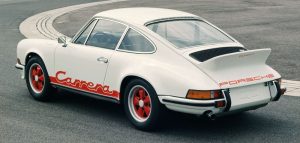
You must be logged in to post a comment.